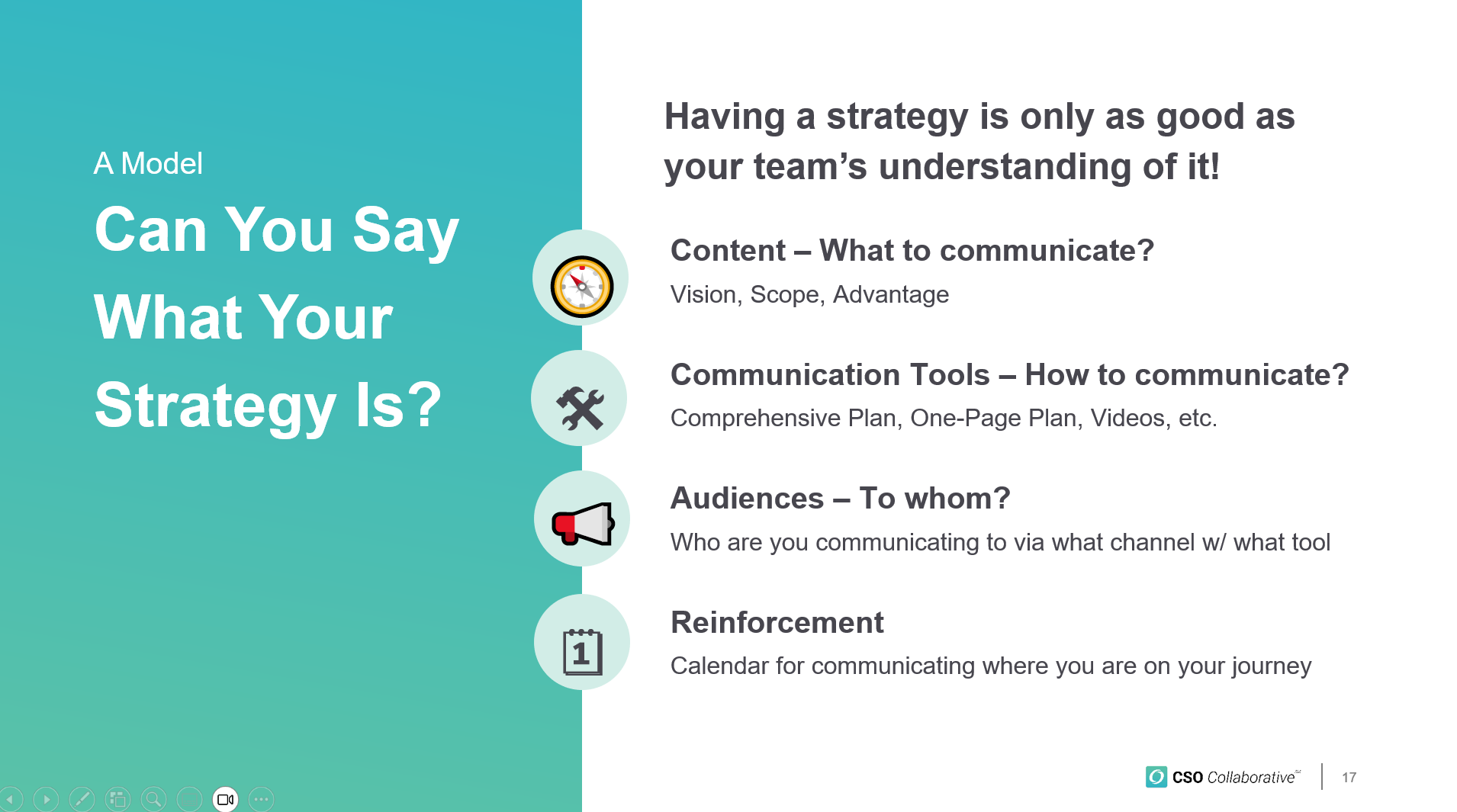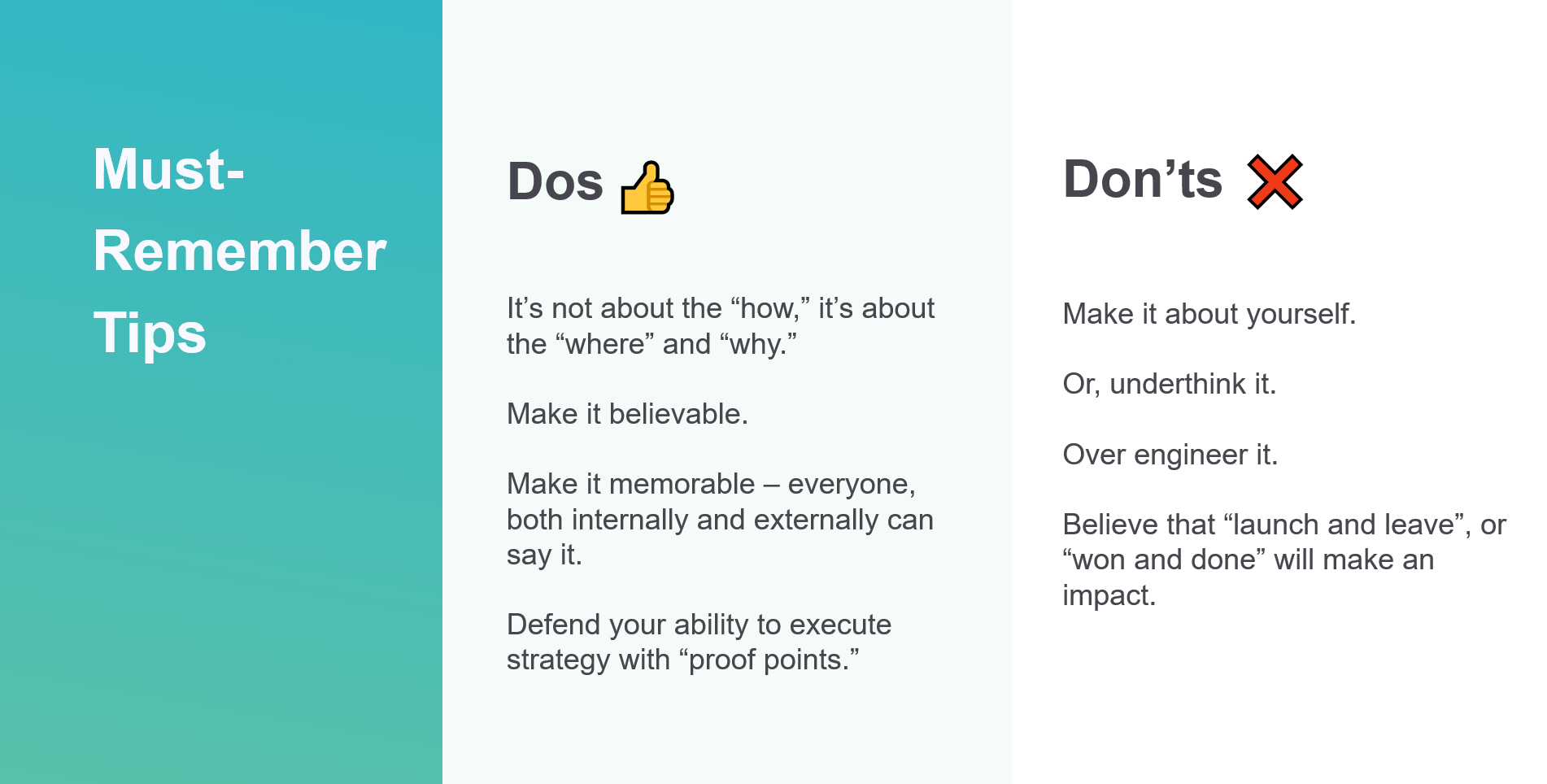Communicate and Storyboard Your 2023 Strategy
Check out the full recording (with the chat transcript) and deck from the session. Here are a few valuable resources to check out before we recap:
- Check out this exercise to help communicate and storyboard your 2023 strategy.
- Here is a practical FREE downloadable guide and storyboard canvas. PS – this is different from a one-page plan.
- Jeff’s Master Class went over the four ways to clearly communicate your strategy. Check out slides 16-24 in the presentation deck for tools and examples.
- Here is our Audience and Deliverable Matrix on slide 23 in the presentation deck.
3 Hot Takeaways for Creating a Clearly Communicated Plan
Creating a clear and convincing plan shows where we are going as an organization, the path we are taking, and most powerfully, why are we doing any of this.
Hot Takeaway #1
Make a Plan That Anyone Can Understand (21:02-29:06)
Speak Your Stakeholders’ “Languages.” Create a plan that can easily be understood by anyone without the need to explain it (check out slide 11). Destination Madison engages a diverse set of stakeholders in driving economic impact through tourism for their city, so their top priority was creating a plan that anyone could understand.
Build with Buy-in. Focus on including multiple stakeholders and staff during the plan creation process. This allows them to understand their part and take true ownership of the plan. Especially with organizations that were hit hard by the pandemic, rebuilding might look differently than it did before 2020, so include all the players, new and old.
Breathe Life into Your Plan! Consider how to keep your plan alive. Ellie not only performs monthly check-ins with her staff on her strategic plan, but she also ties incentives and bonuses into it as well. As she enthusiastically added, “We want our plan to live!”
Overcome Cynicism with a Forward Focus. Apathy develops from years of strategic plans full of empty promises. If your industry has shifted, or even just the players, communicate how you will do things differently than your predecessors. Just be sure you follow-up. As Ellie mentions, open communication and honesty are the best credibility you can create.
Hot Takeaway #2:
Is the Strategy Strategic?(40:30-46:05)
Crystalize a Challenge to Focus On. With the multitude of challenges organizations face, obtaining a clear focus can be overwhelming. Sometimes it makes the most sense to look at your current state and pick a single pressing challenge to solve for and then deepen into internal and external factors.
Create Applicable Guard Rails/Guiding Principles. Our strategies need to be a true compass to guide staff in their day-to-day decision-making (and a place to ground before making the REALLY BIG decisions). Look to stakeholders, leadership, and staff to intentionally create your guiding principles. When we know that we have good, well-documented principles guiding our growth, people can make the best decisions aligned to the vision.
Use Your Plan to Solve Your Challenge. Ask yourself if your strategic plan truly tells the story of your challenge. And like any good story, look to the details–where to play, how to win, and any shifting landscapes you find yourself in.
Write It Down. The power of writing your plan down on paper gets it out of your leadership’s brains and into the rest of the organization. But we all know that projects don’t always move in a linear fashion, so flexibility and agility are key to the process.
Align Your Team. Make sure that the whole team is on the same page for what “good” strategy looks like (competitive advantages, growth strategy, clarity on your challenge, etc.). As Kamryn mentions, your plan needs to align with the picture that people have in their heads.

Hot Takeaway #3:
Can You Clearly Articulate a Convincing Strategy?(48:40-57:45)
Create Poignant and Relatable Content. Your language, perspective, and messaging must be clear and true to who you are. Create your vision with a 360-degree view, scope, and focus that speaks directly to your customers, constituents, communities, and new markets. Make sure you convey this consistently and with consensus. Need help starting? Check out our strategy storyboard and simple exercise.
Use Communication Tools. To clearly articulate your deliverables and strategy performance, you’ll need to use the right tool for the job. Choose the best format to articulate to the right audience–PowerPoints, score cards, one-pagers, videos, or something out-of-the-box. See slides 19-22.
Matrix Your Audiences and Deliverables. Create a matrix for your audiences who need to know the what and the why. This not only ensures that your strategy is connected, but it also guarantees you don’t overlook your timing, purpose, why’s, when’s, and where’s that you have promised to deliver. Find this simple yet effective matrix on slide 23.
Don’t Launch and Leave. Communication and performance of strategy is a continuous process that involves reinforcement. As Jeff says, we’d be missing the boat if we didn’t consistently set a structure and cadence to review our strategy. Here are Jeff’s Do’s and Don’ts Listen to Jeff discuss this at 56:51













